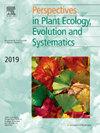不支持以蚂蚁-害虫相互作用为媒介的植物间接防御的最优分配
IF 3.5
3区 环境科学与生态学
Q1 ECOLOGY
Perspectives in Plant Ecology Evolution and Systematics
Pub Date : 2024-09-20
DOI:10.1016/j.ppees.2024.125827
引用次数: 0
摘要
最佳防御理论(ODT)推测,生殖结构应该受到更严密的防御,因为它们对植物的适应性贡献最大,而且受到食草动物攻击的概率也最高。蚂蚁可以通过与半翅目昆虫的互利互动为植物提供间接防御。在这种经过深入研究的相互作用中,蚂蚁为半翅目昆虫提供保护,使其免受天敌(如捕食者和寄生蜂)的侵害,以换取半翅目昆虫分泌的富含糖分的蜜露。反过来,参加半翅目昆虫活动的蚂蚁也可以通过抑制其他有害的食草动物间接地使植物受益。尽管对蚂蚁与半翅目昆虫之间的这种互惠关系进行了大量研究,但以前还没有研究过这种互惠相互作用所介导的植物间接防御的最佳分配模式。在这项研究中,我们评估了热带灌木 Solanum lycocarpum 的无性枝条(仅有叶片)和生殖枝条(有叶片和花序)对蚂蚁-害虫相互作用所介导的间接植物防御的分配以及这种间接防御的有效性是否存在差异。为此,我们选择了生殖枝和无性枝上都有蚂蚁啃食的半翅目昆虫 Enchenopa brasiliensis 聚集的植物。然后,我们估算了间接防御(以植物汁液和半翅目蜜露中糖的产生量以及蚂蚁的吸引力来衡量)及其在蚂蚁保护植物方面的有效性(以啃食叶片的食草动物的损害和存活率来衡量)。与 ODT 的预测相吻合,我们发现生殖枝条中植物汁液的糖分浓度以及半翅目蜜露的糖分浓度均高于无性繁殖枝条。然而,半翅目蜜露中糖浓度的增加并没有导致蚂蚁对生殖枝条产生更大的吸引力。此外,与 ODT 预测相反,我们发现蚂蚁参加半翅目蜜露并没有增强植物对生殖枝条上啃食叶片的食草动物的保护。总之,我们的研究表明,由蚂蚁-半翅目昆虫相互作用介导的番荔枝属植物间接防御分配模式并不支持 ODT 的预测。本文章由计算机程序翻译,如有差异,请以英文原文为准。
No support for the optimal allocation to indirect plant defenses mediated by ant-hemipteran interactions
The Optimal Defense Theory (ODT) postulates that reproductive structures should be more heavily defended because they contribute the most to a plant's fitness and have the highest probability of being attacked by herbivores. Ants can provide indirect defense to plants through their mutualistic interactions with hemipteran insects. In this well-studied interaction, ants provide protection to hemipterans against their natural enemies (e.g., predators and parasitic wasps) in exchange for the sugar-rich honeydew secreted by hemipterans. In turn, ants attending hemipterans can indirectly benefit plants by suppressing other harmful herbivores. Despite the numerous investigations of this ant-hemipteran mutualism, patterns of optimal allocation to indirect plant defenses mediated by this mutualistic interaction have not been previously investigated. In this study, we evaluated whether allocation to indirect plant defenses mediated by ant-hemipteran interactions and the effectiveness of such indirect defenses differ between vegetative branches (with only leaves) and reproductive branches (with leaves and inflorescences) of the tropical shrub Solanum lycocarpum. For this, we selected plants with aggregations of the ant-tended hemipteran Enchenopa brasiliensis in both reproductive and vegetative branches. We then estimated indirect defenses (measured as the production of sugar in the plant sap and hemipteran honeydew, as well as ant attraction), and their effectiveness in terms of plant protection by ants (measured as the damage and survival of leaf-chewing herbivores). Supporting ODT predictions, we found that the sugar concentration in the plant sap, and consequently in hemipteran honeydew, was higher in reproductive than in vegetative branches. However, the increase in sugar concentration in hemipteran honeydew did not result in greater ant attraction to reproductive branches. Additionally, contrary to ODT predictions, we found that ants attending hemipterans did not enhance plant protection against leaf-chewing herbivores on reproductive branches. Overall, our study demonstrated that the patterns of allocation to indirect defenses mediated by ant-hemipteran interactions in S. lycocarpum plants did not support the predictions of the ODT.
求助全文
通过发布文献求助,成功后即可免费获取论文全文。
去求助
来源期刊
CiteScore
6.50
自引率
0.00%
发文量
28
审稿时长
67 days
期刊介绍:
Perspectives in Plant Ecology, Evolution and Systematics (PPEES) publishes outstanding and thought-provoking articles of general interest to an international readership in the fields of plant ecology, evolution and systematics. Of particular interest are longer, in-depth articles that provide a broad understanding of key topics in the field. There are six issues per year.
The following types of article will be considered:
Full length reviews
Essay reviews
Longer research articles
Meta-analyses
Foundational methodological or empirical papers from large consortia or long-term ecological research sites (LTER).

 求助内容:
求助内容: 应助结果提醒方式:
应助结果提醒方式:


